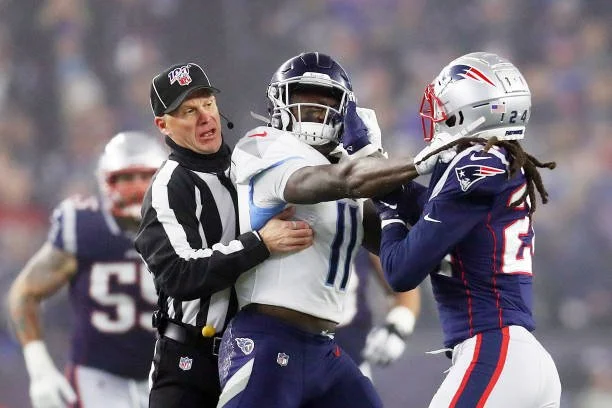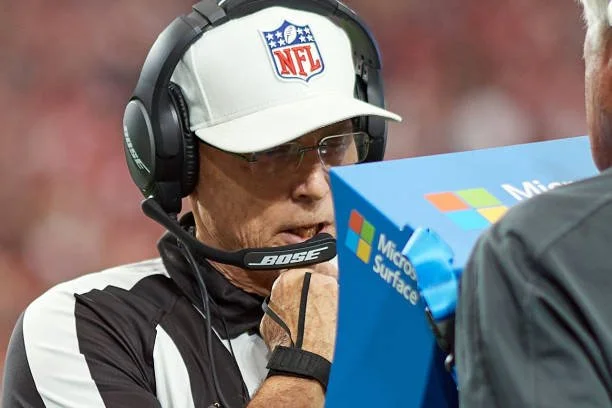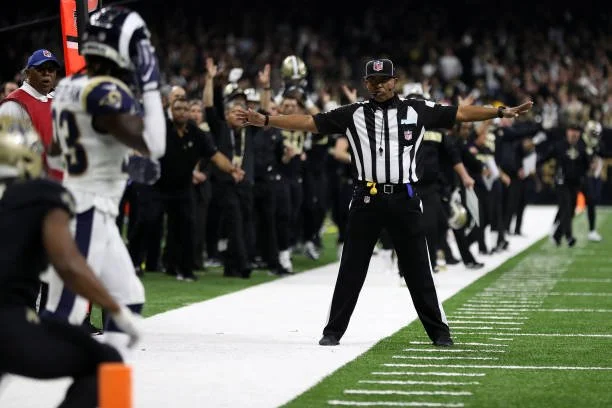Instant Regret: How the Instant Replay has Ruined the NFL
Rules and regulations are the background of any sport—and football is no exception. While police regulate the rules on our streets, referees ensure rules are followed during a football game… but that has changed.
The instant replay was introduced to football to ensure game-changing mistakes are caught. The seven referees on the field can only see so much of the 120 yards.
A defensive penalty called by Referee Carl Cheffers #51, during a game between the Cleveland Browns and the Arizona Cardinals on October 17th in Cleveland, Ohio (Photo by Nick Cammett/Getty Images)
To combat fallacies of the human-eye, multiple cameras watching every square-inch of the field allows for an increased accuracy of the calls that are made. You would think this would negate controversy, but many argue that the instant replay has negatively impacted the sport and ruined the flow of the game.
The first issue presented is that it increases the length of games. Replay reviews often take several minutes, which can slow down the pace of the game. This disruption in tempo frustrates fans and players who must wait for play to resume.
NFL Referees Tom Hill (Left) and Ron Winter (Right) look upon an instant replay monitor during a game between the Pittsburgh Steelers and Cincinnati Bengals on November 20th in Pittsburgh. (Photo by George Gojkovich/Getty Images)
Making sure the play is correct is important, but relying so heavily on the replay degrades the intuitive nature of the sport. Football has relied on the instincts of its officials for many years.
The use of instant replay has created a situation where every play is subject to review. This makes it difficult for referees to make quick decisions on the field.
On January 4th in Foxborough, Massachusetts, a referees separates the players Tennessee Titans A.J. Brown #11 and Stephon Gilmore #24 of the New England Patriots who are in an altercation. (Photo by Maddie Meyer/Getty Images)
Excessive use of the replay has led to a decline in the importance of referees. Referees are now expected to rely on the instant replay to make the correct call, which reduces their authority. This diminishes the importance of their role on the field.
Using the cameras to gauge their decision also leads to difficult calls if the visual information is inadequate. This dilemma further reduces their importance on the field.
NFL referee reviews a play on a portable Instant Replay monitor during a game on October 1st in Glendale, Arizona, between San Francisco 49ers and the Arizona Cardinals. (Photo by Robin Alam/Icon Sportswire via Getty Images).
Another issue is that the players become impacted. Players are now more likely to slow down or stop playing until they know if a call will be reviewed. This can result on lack of effort and intensity on the field.
Moreover, players are also expected to adapt to the new reality of instant replay, which can be challenging for those who have not grown up with it.
On December 1st in Denver, Colorado: Los Angeles Chargers Quarterback Philip Rivers #17 listens to referees discussing a false start penalty on the Charges from the Denver Broncos. (Photo by Justin Edmonds/Getty Images)
Contrary to its intent – instant replay often causes more controversy than what it is meant to negate. Referees are asked to make complex decisions based on limited information, which can lead to incorrect calls.
These incorrect calls are brewed from split-second decisions based on a slow-motion replay. The calls are often difficult to make and controversial.
This brews dissatisfaction among fans because it is opposite to the intuitive way the game used to be played; while a call may seem wrong, it often comes down to if it is technically correct.
A Cleveland Browns fan yelling at the Caronlina Panthers players because they won 13-6 on December 1st. (Photo by Tom Pidgeon/Getty Images)
Lastly, instant replay has created significant financial impacts on the sport. Teams and leagues are spending larges sums of money on replay technology and staffing, which is straining budgets.
The high price to match massive organizations limits the diversity of the sport. It limits the ability of smaller teams to join the league and for new leagues to compete for space.
November 12th, 2000: A view of a referee’s flag during a game between the Buffalo Bills and Chicago Bears at Ralph Wilson Stadium in Orchard Orchard Park, New York. (Rick Stewart//Allsport)
There are many downsides to the use of instant replay, but it is impossible to argue there are no benefits. The tool creates improved accuracy of calls helps disallow controversy. It highlights imperfections of plays and can improve training.
The instant replay modernizes the sport, which can attract new fans. Also, this technology can ensure better safety, reviewing calls that can be dangerous and overall uphold the rules of the game.
Tommylee Lewis #11 of the New Orleans Saints drops a pass broken-up by Los Angeles Rams Nickell Robey-Coleman #23 in New Orleans, Louisiana on January 20th. A referee makes a call in the background. (Photo by Chris Graythen/Getty Images)
While instant replay was introduced to football as a way to improve the accuracy of calls and reduce controversy, it has led to a number of negative impacts on the sport. The technology increases the length of games, reduces the importance of referees, decreases intuitiveness, creates confusion, and has added significant financial implications.
There are many pros and cons to the practice of instant replay. Indisputably, it improves the accuracy of calls and keeps players from deviating from the rules. Whether you like it or not, ultimately the call is up to you.







